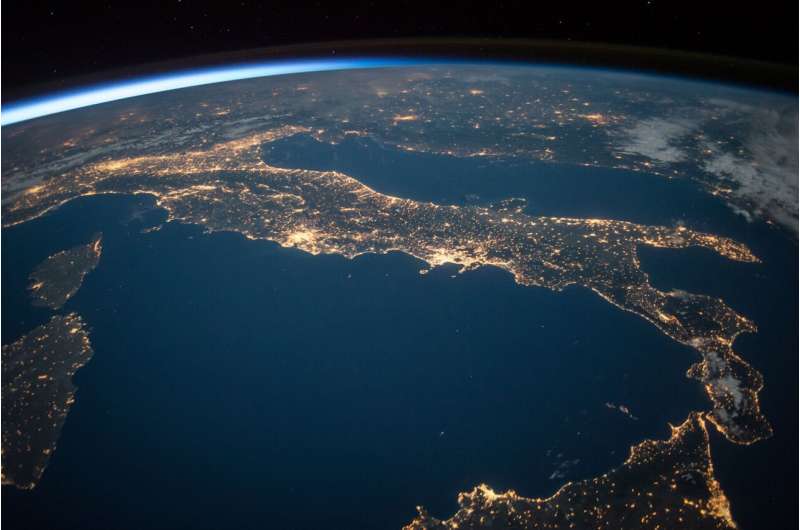Weird space weather seems to have influenced human behavior on Earth 41,000 years ago

Lisa Lock
scientific editor

Andrew Zinin
lead editor

Our first meeting was a bit awkward. One of us is an who studies how past peoples . Two of us interactions between and .
When we first got together, we wondered whether our unconventional project, linking space weather and human behavior, could actually bridge such a vast disciplinary divide. Now, two years on, we believe the payoffs—personal, professional and scientific—were well worth the initial discomfort.
Our collaboration, which culminated in a recent paper in the journal , began with a single question: What happened to life on Earth when the planet's nearly collapsed roughly 41,000 years ago?
Weirdness when Earth's magnetic shield falters
This near-collapse is known as the , a brief but extreme geomagnetic event in France where it was . At the time of the Laschamps Excursion, near the end of the , Earth's magnetic poles didn't reverse as they . Instead, they wandered, erratically and rapidly, over thousands of miles. At the same time, the strength of the magnetic field dropped to less than 10% of its modern day intensity.
So, instead of behaving like a stable bar magnet—a —as it usually does, Earth's magnetic field fractured into multiple weak poles across the planet. As a result, the protective force field scientists call the magnetosphere became distorted and leaky.
The normally deflects much of the and harmful ultraviolet radiation that would otherwise reach Earth's surface.
So, during the Laschamps Excursion when the magnetosphere broke down, our models suggest a number of near-Earth effects. While there is still work to be done to precisely characterize these effects, we do know they included —normally seen only in skies as the Northern Lights or Southern Lights—wandering toward the equator, and significantly higher-than-present-day doses of .
The skies 41,000 years ago may have been both spectacular and threatening. When we realized this, we two geophysicists wanted to know whether this could have affected people living at the time.
The archaeologist's answer was absolutely.
Human responses to ancient space weather
For people on the ground at that time, may have been the most immediate and striking effect, perhaps inspiring awe, fear, ritual behavior or something else entirely. But the archaeological record is notoriously limited in its ability to capture these kinds of .
Researchers are on firmer ground when it comes to the . With the weakened magnetic field, more harmful radiation would have reached Earth's surface, elevating risk of sunburn, eye damage, , and other .
In response, people may have adopted practical measures: spending more time in caves, producing tailored clothing for better coverage, or applying mineral pigment "sunscreen" made of ochre to their skin. As we describe in our recent paper, the frequency of these across parts of Europe, where effects of the Laschamps Excursion were pronounced and prolonged.
At this time, both Neanderthals and members of our species, Homo sapiens, were living in Europe, though their geographic distributions likely overlapped only in certain regions. The archaeological record suggests that different populations exhibited distinct approaches to environmental challenges, with some groups perhaps more reliant on shelter or material culture for protection.
Importantly, we're not suggesting that space weather alone caused an increase in these behaviors or, certainly, that the Laschamps caused Neanderthals to go extinct, which is . But it could have been a contributing factor—an invisible but powerful force that influenced innovation and adaptability.
Cross-discipline collaboration
Collaborating across such a disciplinary gap was, at first, daunting. But it turned out to be deeply rewarding.
Archaeologists are used to reconstructing now-invisible phenomena like climate. We can't measure past temperatures or precipitation directly, but they've left traces for us to interpret if we know .
But even archaeologists who've spent years studying the effects of climate on and may not have considered the effects of the and space weather. These effects, too, are invisible, powerful and best understood through indirect evidence and modeling. Archaeologists can treat space weather as a vital component of Earth's environmental history and future forecasting.
Likewise, geophysicists, who typically work with large datasets, models and simulations, may not always engage with some of the stakes of space weather. Archaeology adds a human dimension to the science. It reminds us that the effects of space weather don't stop at the . They can ripple down into the lived experiences of people on the ground, influencing how they adapt, create and survive.
The Laschamps Excursion wasn't a fluke or a one-off. Similar disruptions of Earth's magnetic field have happened before and will happen again. Understanding how ancient humans responded can provide insight into how future events might affect our world—and perhaps even help us prepare.
Our unconventional collaboration has shown us how much we can learn, how our perspective changes, when we cross disciplinary boundaries. Space may be vast, but it connects us all. And sometimes, building a bridge between Earth and space starts with the smallest things, such as ochre, or a coat, or even sunscreen.
Journal information: Science Advances
Provided by The Conversation
This article is republished from under a Creative Commons license. Read the .![]()




















